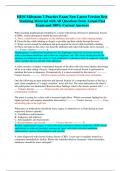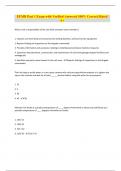HESI Milestone 2 Practice Exam New Latest Version Best
Studying Material with All Questions from Actual Past
Exam and 100% Correct Answers
When teaching diaphragmatic breathing to a client with chronic obstructive pulmonary disease
(COPD), which information should the nurse provide?
A. Place a small book or magazine on the abdomen and make it rise while inhaling deeply.
B. Purse the lips while inhaling as deeply as possible and then exhale through the nose.
C. Wrap a towel around the abdomen and push against the towel while forcefully exhaling.
D. Place one hand on the chest, one hand the abdomen and make both hands move outward. -----
------ Correct Answer ------------ A
Diaphragmatic or abdominal breathing uses the diaphragm instead of accessory muscles to
achieve maximum inhalation and to slow the respiratory rate. The client should protrude the
abdomen on inhalation and contract it with exhalation, so placing a book or magazine, helps the
client visualize the rise and fall of the abdomen.
A client sustains a complex comminuted fracture of the tibia with soft tissue injuries after being
hit by a car while riding a bicycle. Surgical placement of an external fixator is performed to
maintain the bone in alignment. Postoperatively it is most essential for the nurse to? -----------
Correct Answer ------------ Perform a neurovascular assessment of both lower extremities
One day following an open reduction and internal fixation of a compound fracture of the leg, a
male client complains of "a tingly sensation" in his left foot. The nurse determines the client's
left pedal pulses are diminished. Based on these findings, what is the client's greatest risk? -------
---- Correct Answer ------------ Neurovascular and circulation compromise related to
compartment syndrome
The nurse is caring for a client with a fractured right elbow. Which assessment finding has the
highest priority and requires immediate intervention? ----------- Correct Answer ------------ Deep
unrelenting pain in the right arm
What types of medications should the nurse expect to administer to a client during an acute
respiratory distress episode?
A. Vasodilators and hormones.
B. Analgesics and sedatives.
C. Anticoagulants and expectorants.
D. Bronchodilators and steroids. ----------- Correct Answer ------------ D
Besides supplemental oxygen, a client with acute respiratory distress syndrome (ARDS) needs
medications to widen air passages, increase air space, and reduce alveolar membrane
inflammation, such as bronchodilators and steroids.
A client diagnosed with chronic kidney disease (CKD) 2 years ago is regularly treated at a
community hemodialysis facility. Before the scheduled dialysis treatment, which electrolyte
imbalance should the nurse anticipate?
,A. Hypophosphatemia
B. Hypocalcemia
C. Hyponatremia
D. Hypokalemia ----------- Correct Answer ------------ B
Hypocalcemia develops in CKD because of chronic hyperphosphatemia, not option A. Increased
phosphate levels cause the peripheral deposition of calcium and resistance to vitamin D
absorption needed for calcium absorption. Prior to dialysis, the nurse would expect to find the
client hypernatremic and hyperkalemic, not with option C or D.
The nurse is assessing a 75-year-old client for symptoms of hyperglycemia. Which symptom of
hyperglycemia is an older adult most likely to exhibit?
A. Polyuria
B. Polydipsia
C. Weight loss
D. Infection ----------- Correct Answer ------------ D
Signs and symptoms of hyperglycemia in older adults may include fatigue, infection, and
evidence of neuropathy (e.g., sensory changes). The nurse needs to remember that classic signs
and symptoms of hyperglycemia, such as options A, B, and C and polyphagia, may be absent in
older adults.
The post-operative client states to the nurse, "I hate the feeling of those compression stockings as
they inflate and deflate all the time. It keeps me awake." What is the nurse's best response?
A. "They are for your own good."
B. "Your health care provider ordered them. You have no choice but to wear them."
C. "They are to help prevent blood clots. Do you want that to happen, do you?"
D. "Tell me what you know about the intermittent compression stockings." ----------- Correct
Answer ------------ D
The purpose of the intermittent compression stockings is to decrease the risk of blood clots
forming in the legs. By assessing the client's knowledge about the devise, the nurse can
determine if the client is aware of the potential for blood clots and the sequela that clots have. By
answering "They are for your own good," the nurse dismisses the client's concerns. Having no
choice about treatment does not acknowledge client autonomy. The "Do you want that to happen
to you" is a statement using coercion by fear.
A 46-year-old female client is admitted for acute renal failure secondary to diabetes and
hypertension. Which test is the best indicator of adequate glomerular filtration?
A. Serum creatinine.
B. Blood Urea Nitrogen (BUN).
C. Sedimentation rate.
D. Urine specific gravity. ----------- Correct Answer ------------ A
Creatinine is a product of muscle metabolism that is filtered by the glomerulus, and blood levels
of this substance are not affected by dietary or fluid intake. An elevated creatinine strongly
indicates nephron loss, reducing filtration.
A splint is prescribed for nighttime use by a client with rheumatoid arthritis. Which statement by
the nurse provides the most accurate explanation for use of the splints?
,A. Prevention of deformities.
B. Avoidance of joint trauma.
C. Relief of joint inflammation.
D. Improvement in joint strength. ----------- Correct Answer ------------ A
Splints may be used at night by clients with rheumatoid arthritis to prevent deformities caused by
muscle spasms and contractures.
The nurse assesses a client with advanced cirrhosis of the liver for signs of hepatic
encephalopathy. Which finding would the nurse consider an indication of progressive hepatic
encephalopathy?
A. An increase in abdominal girth.
B. Hypertension and a bounding pulse.
C. Decreased bowel sounds.
D. Difficulty in handwriting. ----------- Correct Answer ------------ D
A daily record in handwriting may provide evidence of progression of hepatic encephalopathy
leading to coma.
A client who is receiving chemotherapy asks the nurse, "Why is so much of my hair falling out
each day?" Which response by the nurse best explains the reason for alopecia?
A. "Chemotherapy affects the cells of the body that grow rapidly, both normal and malignant."
B. "Alopecia is a common side effect you will experience during long-term steroid therapy."
C. "Your hair will grow back completely after your course of chemotherapy is completed."
D. "The chemotherapy causes permanent alterations in your hair follicles that lead to hair loss." -
---------- Correct Answer ------------ A
The common adverse effects of chemotherapy (nausea, vomiting, alopecia, bone marrow
depression) are due to chemotherapy's effect on the rapidly reproducing cells, both normal and
malignant.
The nurse is preparing a teaching plan for a client who is newly diagnosed with Type 1 diabetes
mellitus. Which clinical cues should the nurse describe when teaching the client about
hypoglycemia?
A. Sweating, trembling, tachycardia.
B. Polyuria, polydipsia, polyphagia.
C. Nausea, vomiting, anorexia.
D. Fruity breath, tachypnea, chest pain. ----------- Correct Answer ------------ A
Sweating, dizziness, and trembling are signs of hypoglycemic reactions related to the release of
epinephrine as a compensatory response to the low blood sugar.
The healthcare provider prescribes aluminum and magnesium hydroxide, 1 tablet PO PRN, for a
client with chronic kidney disease (CKD) who is complaining of indigestion. Which intervention
should the nurse implement?
A. Administer 30 minutes before eating.
B. Evaluate the effectiveness 1 hour after administration.
C. Instruct the client to swallow the tablet whole.
D. Question the healthcare provider's prescription. ----------- Correct Answer ------------ D
Magnesium agents are not usually used for clients with CKD due to the risk of
, hypermagnesemia, so this prescription should be questioned by the nurse.
A client with multiple sclerosis has experienced an exacerbation of symptoms, including
paresthesias, diplopia, and nystagmus. Which instruction should the nurse provide?
A. Stay out of direct sunlight.
B. Restrict intake of high protein foods.
C. Schedule extra rest periods.
D. Go to the emergency room immediately. ----------- Correct Answer ------------ C
Exacerbations of the symptoms of MS occur most commonly as the result of fatigue and stress.
The client should be encouraged to schedule extra rest periods to help reduce the symptoms.
The nurse is assessing a client with bacterial meningitis. Which assessment finding indicates the
client may have developed septic emboli?
A. Cyanosis of the fingertips.
B. Bradycardia and bradypnea.
C. Presence of S3 and S4 heart sounds.
D. 3+ pitting edema of the lower extremities. ----------- Correct Answer ------------ A
Septic emboli secondary to meningitis commonly lodge in the small arterioles of the extremities,
causing a decrease in circulation to the hands which may lead to gangrene.
An elderly client is admitted with a diagnosis of bacterial pneumonia. When observing the client
for the first signs of decreasing oxygenation, the nurse should assess for which clinical cues?
A. Abdominal distention.
B. Undue fatigue.
C. Cyanosis of the lips.
D. Confusion and tachycardia. ----------- Correct Answer ------------ D
The onset of pneumonia in the elderly may be signaled by general deterioration, confusion,
increased heart rate or increased respiratory rate due to the decreased oxygen- carbon dioxide
exchange at the alveoli, known as the V-Q mismatch. Cyanosis is a very late sign.
A 77-year-old female client is admitted to the hospital. She is confused, has no appetite, is
nauseated and vomiting, and is complaining of a headache. Her pulse rate is 43 beats per minute.
It is most important for the nurse to assess for which finding?
A. Wearing dentures.
B. Use of aspirin prior to admit.
C. Prescribed nitroglycerin for chest pain.
D. Takes digitalis. ----------- Correct Answer ------------ D
Although it is important to obtain a complete medication history, the symptoms described are
classic for digitalis toxicity, and assessment of this problem should be made promptly. Elderly
persons are particularly susceptible to digitalis intoxication which manifests itself in such
symptoms as anorexia, nausea, vomiting, diarrhea, headache, and fatigue.
The nurse is interviewing a male client with hypertension. Which additional medical diagnosis in
the client's history presents the greatest risk for developing a cerebral vascular accident (CVA)?
A. Diabetes mellitus.
B. Hypothyroidism.





